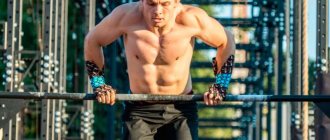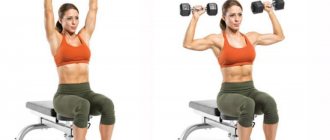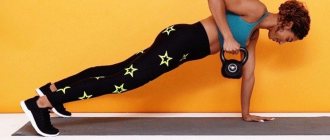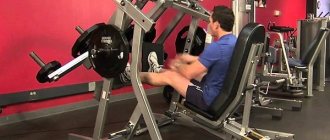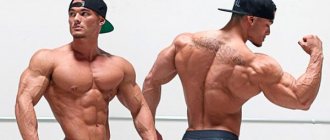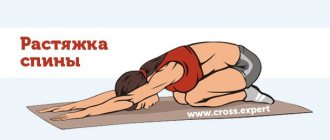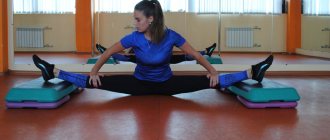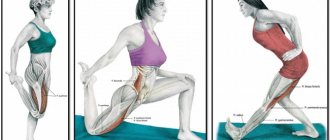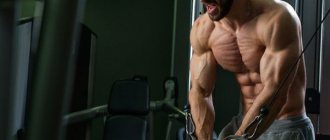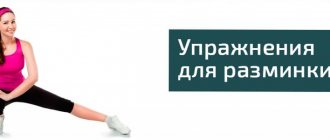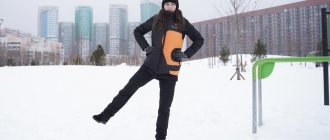© Africa Studio — stock.adobe.com
Share:
We have prepared for you the most effective exercises for stretching the muscles of the arms, forearms and shoulder girdle. Remember that the main thing in stretching is not to do the exercise until pain occurs. You always need to know when to stop and progress gradually.
For the front of the shoulders
Stretch the front deltoid:
- Standing, feet shoulder-width apart. Hands behind your back, one clasping the other's wrist.
- Raise your wrists as high as possible and bend your elbows. The chest needs to be arched forward. Shoulders tense. You will feel the front of your shoulder stretch.
How to get the most benefit
- Don't forget about the preliminary warm-up. Be sure to include exercises with bending and rotating your arms. Read about warming up before stretching here →
- Don’t try to complete all the difficult exercises the first time, work towards the result gradually.
- After completing a set of exercises, lie on the mat on your back and relax, hold in this position for a couple of minutes. This will relieve tension and promote speedy recovery and muscle tone.
For the middle part of the shoulders
This exercise allows you to stretch your middle deltoids:
- Stand straight with your feet shoulder-width apart.
- Press one hand to the body in a position as in the photo below. With the fingers of your other hand, grab your elbow and pull it to the side and down. Do not move the shoulder itself to the side; it should be fixed in one place.
- Repeat with the other hand.
The benefits of sports
In the 21st century, billions of people prefer an active lifestyle to a sedentary one. It is enough to go outside to confirm these words. This is how you meet older people doing Nordic walking, adults playing football, basketball and teenagers who spend their free time on the horizontal bar or uneven bars. Centuries later, people began to live life to the fullest. Efforts in sports then have a positive effect on the general condition of a person. People feel more resilient, their body is constantly toned, and colds are long forgotten in the past. And this is far from the main thing, since self-confidence also appears, which completely eliminates the occurrence of depression and a lethargic state. Scientists have proven that people who prefer an active lifestyle are more productive and creatively developed than those who constantly watch TV and like to drink a couple of bottles of alcoholic beverages.
Much of the medical and scientific literature confirms the fact that poor health is not only the result of a poor environment, but is largely due to insufficient physical activity. Yes, the environment is not as good as it was 200 years ago, but you can come to terms with this by giving your body healthy foods and doing stretching or more challenging exercises.
For the back of the shoulders
The exercise is aimed at stretching the posterior delta and rotator cuff:
- The body position is the same.
- Raise one arm until it is parallel to the floor and, without bending, reach across your chest to the other shoulder. Use your other hand to help at the elbow at the end of the movement. The body remains motionless.
- Repeat the movement for the other hand.
© Jacob Lund — stock.adobe.com
Recommendations
- Most often, exercises are performed at the end of strength training.
- Body tissues are better able to stretch after they are warmed up. To do this, you need to do a light and simple warm-up before stretching.
- It is important to perform stretching sequentially: starting with the head and neck, gradually moving on to exercises on the chest, back, and lastly the legs.
- It is important not to forget about breathing. Evenly, calmly, with deep breaths and exhalations.
Triceps stretch
You can stretch the triceps brachii muscle in the following way:
- Stand straight, bend your knees slightly.
- Place your arm bent at the elbow behind your head. The shoulder should be perpendicular to the floor.
- With your other hand, grab your working elbow and press, trying to bring it even further behind your head. The elbow of the hand you are pulling should be bent as much as possible, the palm reaching towards the shoulder blades (towards the spine). The torso remains straight.
- Switch hands.
© ikostudio — stock.adobe.com
Benefits of Muscle Stretching
Now let's figure out why you need to stretch your triceps.
Bodybuilding has long accumulated extensive practical experience confirming the benefits of stretching for accelerating the growth of muscle mass and strength.
More about the advantages:
- Before training, prepares muscles and ligaments for upcoming intense loads and reduces the risk of injury
- After each triceps approach, muscle recovery is accelerated by 15-20%
This helps you train more intensely (do more exercises, approaches, repetitions) without increasing the duration of the session.
- After strength training, it improves post-workout recovery, accelerating the rate of muscle growth
- Promotes the formation of beautiful shapes and outlines of the muscle
It has long been known that with prolonged strength training, the muscle shortens and takes on an unaesthetic appearance. To avoid this effect, you need to stretch after every workout.
Biceps stretch
Exercise for the biceps brachii muscle:
- Hook your fingers on a doorframe or other similar surface with your elbow facing up and your thumb pointing down. The hand is parallel to the floor.
- Move your body forward a little.
- Repeat for the other hand.
Best time to do it
As we have already indicated above, triceps stretching is done in three cases - before the start of training, immediately during the period of strength training and at the end of it.
Before training, stretching is more dynamic and carried out at half strength. In the sense that maximum stretching with excessive force is not applied here.
The main goal of such activity is to prepare the muscles, joints and ligaments for the upcoming loads by warming them up beforehand. This procedure reduces the risk of injury during exercise.
Light stretching of the triceps is mandatory before each workout, not only of the arms, but also before pumping the chest and shoulders (where the triceps is also actively involved).
Let's move on.
The situation when the triceps is filled with blood ( “clogged” ) is quite standard during pump training. In this case, the performance of the muscle decreases significantly and further continuation of the exercise becomes ineffective.
To prevent or reduce this phenomenon, you can stretch the target muscle after each set. This helps open the smallest blood vessels - capillaries, and improve blood supply to the muscles.
As a result, the recovery of the triceps is accelerated during the training itself, which means that the performance and return from the exercise increases.
Stretching is also practiced after the end of the power load . But if you stretch your muscles during the exercise itself, then after it you can do without it.
Triceps and Shoulder Stretch
This is a complex exercise that allows you to stretch both the triceps and shoulders at once:
- Feet shoulder-width apart, slightly bent.
- The hand of one hand is placed behind the back from below. The palm turned outward is pressed to the back.
- The other hand also goes back, but over the top. The elbow looks up, with our fingers we reach the tips of the fingers of the second hand. Try to close your fingers into a lock. This may not work at first; a simple touch will be enough. If this doesn’t work, use a rope and “crawl” along it with your fingers towards each other. Over time you will be able to touch them.
- Switch hands and repeat the movement.
© bnenin — stock.adobe.com
Shoulders are more than just deltoids
“It’s important to remember that the shoulders are not a separate and independent part of the body, they are connected to the neck, ribs and shoulder blades - they are a whole complex,” says physiotherapist Marian Ryan.”
A short excursion into anatomy: The shoulder girdle includes the humerus, collarbone, rib cage, ribs and, perhaps most importantly, the shoulder blades. The main advantage of this belt is the wide range of motion of the upper body (for example, we can assume a wheel pose and throw curveballs). The main disadvantage: this entire area depends on the ligaments and stabilizer muscles. Therefore, when these muscles are overstrained, we feel pressure and have difficulty performing “broad gestures.”
“Arm and shoulder stretches are designed to properly train the flexibility and mobility of the shoulder area to avoid pain and maintain maximum functionality,” says Wu. The best option is to move your shoulders up and down and back and forth as often as possible throughout the day. But if you still feel excessive tension after a working day, then the following stretching exercises for your arms and shoulders are definitely for you.
Wrist Extensor Stretch
This exercise stretches the muscles on the front of the forearms:
- Sit on the floor on your knees. Place your hands forward so that the backs of your palms rest on the floor and your fingers point toward each other. Hands shoulder width apart.
- Strive, clenching your fists and leaning forward with your whole body, to transfer the weight of your torso to your hands.
13 best yoga exercises to stretch the shoulder girdle
To get the maximum benefit and relieve pain in the problem area, try to keep your body relaxed, as this will allow it to stretch better. And once you get into the position, hold for 20-30 seconds .
Neck stretch
If you realize that you have problems in the upper part of the shoulders, close to the neck, then this exercise will provide some relief.
Technique:
- Sit on the floor and cross your legs. Pull your shoulders down and back.
- Tilt your head towards your right shoulder. Don't lift your right shoulder up to reach your head. Instead, focus on stretching your neck and keeping your shoulder in place.
- You can stop here and then repeat on the other side, or you can increase the stretch by slightly pulling your head toward your shoulder with your right hand.
- Repeat with the other shoulder.
Reverse plank
The reverse plank stretches the triceps and the front of the pecs, and also targets slouching, which can cause tension and pain in the shoulders.
Another benefit is strengthening your back muscles, which will ultimately work to return your shoulders to their proper position.
Technique:
- Sit on the floor with your knees bent in front of you.
- Place your hands 40cm behind and wider than your hips; Point your fingers forward.
- Bend your elbows slightly, inhale, and lift your hips up. Straighten your arms and keep your chest open and lifted.
- You can stop here or go further by throwing your head back (but without letting it sag) and straightening your legs.
- Engage your hips so that your legs are straight and avoid sagging your hips.
Chest opening with tape
This yoga exercise is better known as a shoulder opener and is great for lengthening the pectoral muscles while relieving muscle tension in the shoulders.
Technique:
- Stand up and hold the yoga band behind you.
- Fasten the tape with your palms facing forward. Your hands should be far enough apart that you have enough tension, as you should feel the muscle stretch.
- Increase the stretch by moving your arms closer together and slowly lifting them behind you.
- Be sure to keep your shoulders still throughout this exercise.
Pose in the saddle
The saddle position pulls on the front of the chest and hip flexors, all of which will cause rounding and tension in the upper back if the muscles are not stretched. This exercise also applies gentle pressure to the upper back and shoulders, working to relieve spasm.
Technique:
- Sit on your legs, place your knees at a comfortable distance from each other.
- Now gently lower your back to the floor, resting on your elbows.
- At this point, you may feel enough tension in your quads and pecs to stop. However, you can complete the exercise until your shoulders drop completely to the floor to make the position truly complete.
Eagle pose
Eagle pose deeply stretches the entire shoulder girdle and upper back. It can also stretch the back lower, but this requires a lot of balance, so we'll just focus on the upper body for now.
Technique:
- Stand up with your shoulders back and down.
- Stretch your arms out in front of you. Place your right hand under your left.
- Bend your elbows and wrap your right arm around your left, like a snake. Touch your palms.
- Hold this position or increase the stretch by beginning to gently lift your elbows, still keeping your palms together.
- If your palms don't quite touch each other yet, try touching with the back of your hand.
Gomukhasana (Cow Head Pose)
Gomukhasana works the entire shoulder girdle area, stretches the pectoral muscles and eliminates muscle tension. (If you can't clasp your hands behind your back, you can use a strap.)
Technique:
- Sit on the floor.
- Raise your right hand up and behind your back (as if you were patting yourself on the back).
- Now touch your lower back. Try touching your fingertips together.
- You can end here, or try wrapping both hands around your wrists to gently open your hands.
- Hold this position for a few breaths and switch hands.
Eye of the Needle Pose
Eye of the needle pose is designed to stretch the shoulders and upper back. It is ideal for relieving tension and spasms around the shoulder blades.
Technique:
- Start in a table position (arms directly under your shoulders, knees under your hips).
- Inhale and lift your right arm up, stretching your pectoral muscles.
- Now lower your hand and place it under your left arm and pectoral muscle.
- Let your right shoulder touch the floor, then reach your left hand in front. Pay close attention to your technique.
- Repeat the same exercise with the opposite shoulder.
Cat and cow pose
Cow-Cat pose works to release tension in the back and shoulders and is a great complement to many of the exercises listed in this article.
Technique:
- Start in Table Pose with your arms and legs directly under your shoulders and hips.
- With a neutral spine, begin to exhale and round your back upward. Hold for a few seconds.
- Inhale and arch your back, lifting your head, looking up.
- Continue alternating between cat and cow poses for about 15 repetitions.
Uttanasana
This pose provides a deep stretch to the shoulders as well as the neck.
Technique:
- Stand in a wide stance, with your feet approximately 1 – 1.3 m apart.
- Clasp your hands behind your back, pressing your palms together.
- Lean forward, resting on your hips. Lower your arms overhead toward the floor, making sure your shoulders don't touch your neck.
- To return to the rack, engage your glutes and hamstrings to help you return to your starting position.
Shoulder stretch with yoga band
This exercise is one of the simplest yoga shoulder exercises that you can do anywhere you have a yoga band.
Technique:
- Stand with your feet shoulder-width apart.
- Hold the band in both hands, lift it above your head, then pull it back slightly.
- Make sure there is enough tension so that you feel tension in your arms and upper back.
- Do the amount of exercise that is acceptable to you.
Child's Pose
Child's pose provides a good stretch for the shoulders and chest and reduces tension.
Technique:
- Sit on your tiptoes. Bend forward onto your hips, keeping your arms in front of you and your forehead touching the floor.
- Extend your arms as far as necessary until you feel a stretch in your upper and side back.
Snake pose
Snake pose opens the chest and stretches the front of the shoulders. This helps return your shoulders to the correct position, which helps prevent muscle pain.
Technique:
- Lie face down on the mat.
- Place your hands behind your back and press your feet to the mat.
- Lift your chest off the floor by squeezing your hands. Look down at the mat to avoid straining your neck.
- Hold for 5 to 10 breaths, then release your arms and press your cheek to the mat.
Bridge with clasped hands
This pose simultaneously strengthens and stretches the entire back while placing gentle pressure on the shoulders, eliminating any tension.
Technique:
- The pelvis lies on the floor, knees bent.
- Keeping your knees pointing straight forward, lift your hips up.
- With your hips lifted, place your hands on the floor and clasp them under your thighs.
- Hold this position for a few seconds and lower back to the ground. Do a reasonable number of repetitions.
Main rules of stretching
To fully understand the picture of how to stretch the biceps, you need to know the main stretching positions:
- Exercises are performed only on warmed muscles
If stretching is done before training, as an element of warm-up, then the movements are performed only half-heartedly.
Since the muscles and joints are not yet sufficiently warmed up, the risk of injury by stretching too intensely increases.
- The main stretch is performed at the end of a strength training session.
Again, the muscles and ligamentous apparatus are maximally warmed up and the likelihood of injury is minimized.
- All movements are performed slowly, with a gradual increase in effort
It is strictly forbidden to make sudden, jerking movements.
- The moment of peak stretching is recorded on average for 10-30 seconds
- They also come out of the peak position smoothly and without jerking
